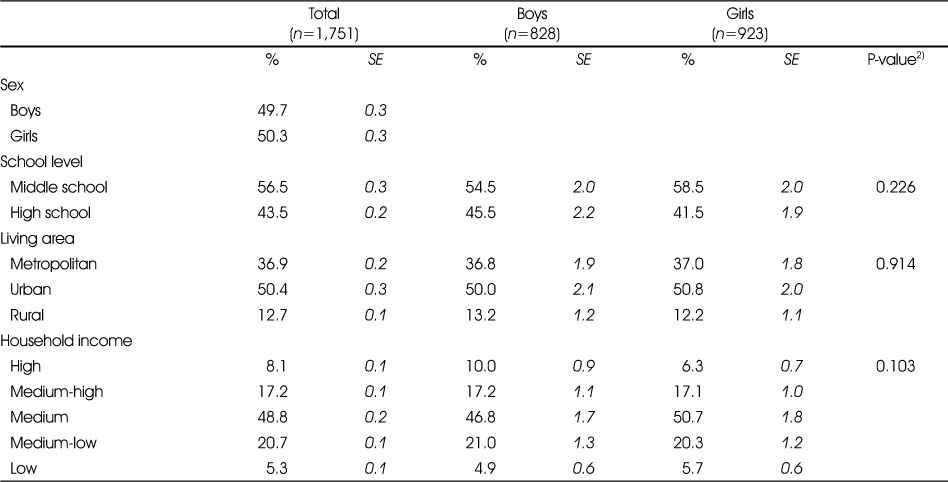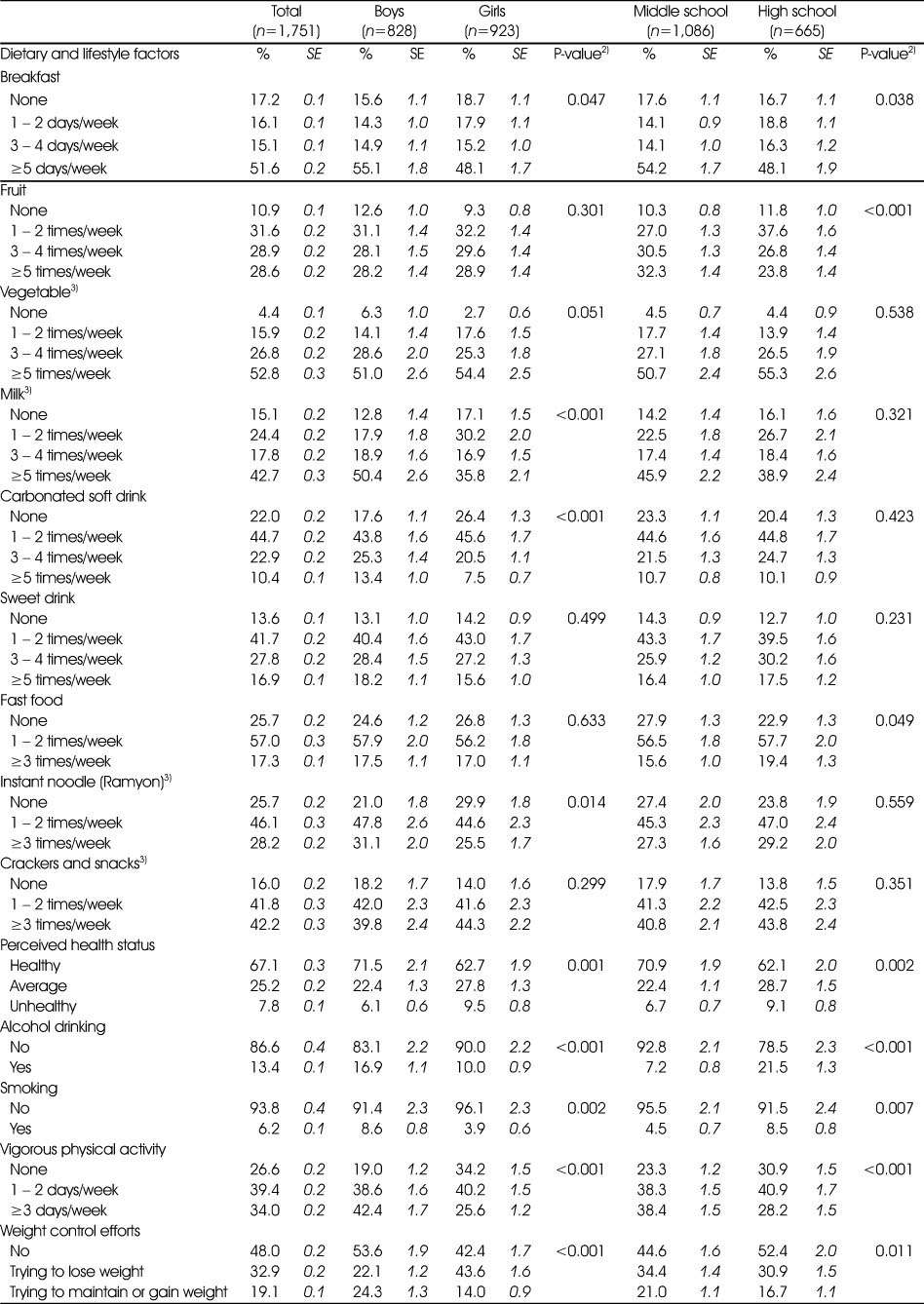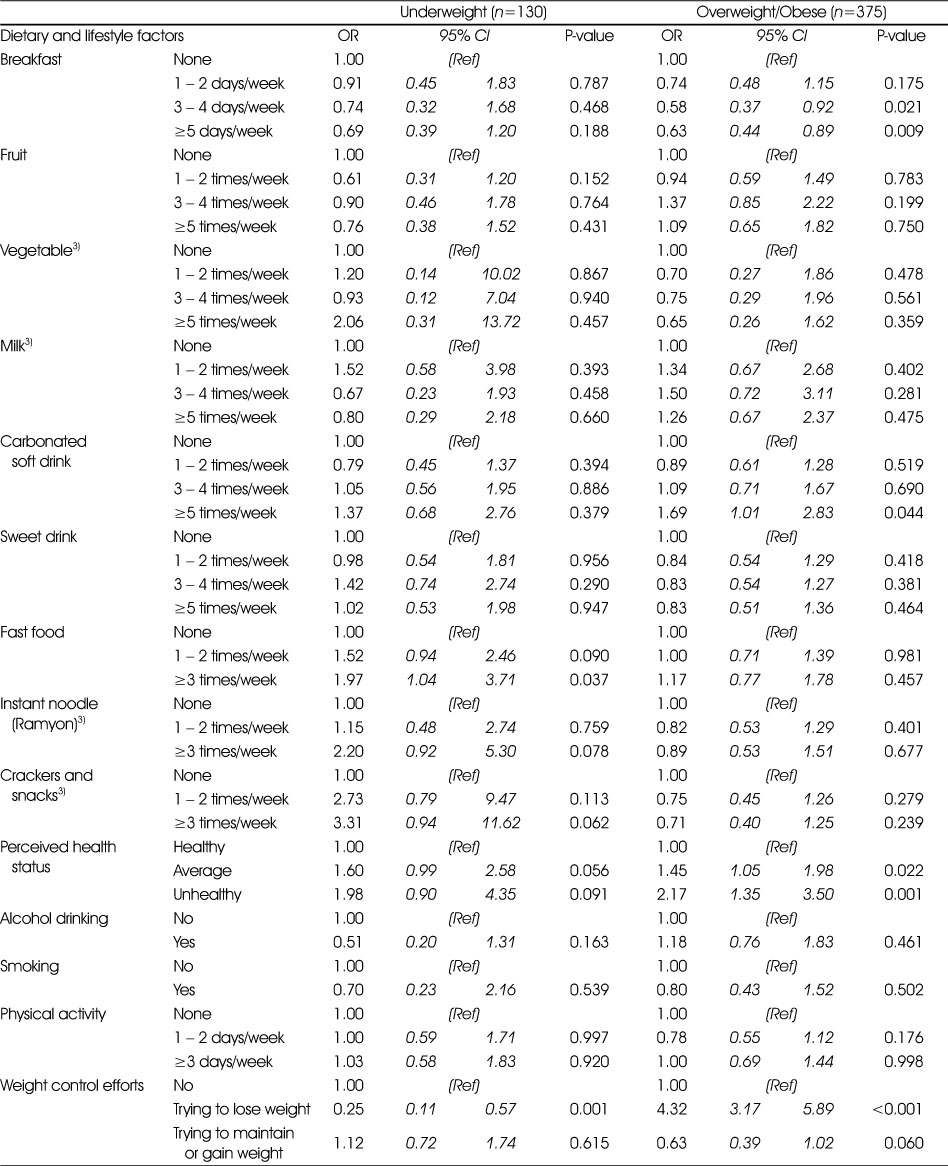References
1. Ministry of the Interior and Safety. 2015 Population census Sejong: Ministry of the Interior and Safety; 2016.
2. Korean Women's Development Institute. An analysis on the national survey of multicultural families 2015 Seoul: Korean Women's Development Institute; 2016.
3. Statistics Korea. Dynamics of multicultural population statistics 2017 Daejeon: Statistics Korea; 2018.
4. Kim HR. Health status of marriage-based immigrants in Korea and policy directions Seoul: Korea Institue for Health and Social Affairs; 2010.
5. Kim H, Yoo S, Cho S, Kwon EJ, Kim S, Park JY. Health status and associated health risks among female marriage immigrants in Korea. Korean J Health Educ Promot 2010;27(5):79–89.
6. Seo IJ, Park JS. Health promoting behaviors, health problems and self-rated health status in female marriage immigrant in Korea. J Digit Converg 2013;11(4):369–382.
7. Kim JM, Lee HS, Kim MH. Food adaptation and nutrient intake of female immigrants into Korea through marriage. Korean J Nutr 2012;45(2):159–169.
8. Kim JM, Lee NH. Analysis of the dietary life of immigrant women from multicultural families in the Daegu area. J Korean Diet Assoc 2009;15(4):405–418.
9. Ministry of Education. 2018 Korea school health examination survey Sejong: Ministry of Eeducation; 2019.
10. Kwon E, Nah EH. Secular trends in height, weight and obesity among Korean children and adolescents in 2006–2015. Korean J Health Educ Promot 2016;33(2):1–13.
11. Kim KE, Kim SH, Park S, Khang YH, Park MJ. Changes in prevalence of obesity and underweight among Korean children and adolescents: 1998-2008. Korean J Obes 2012;21(4):228–235.
12. de Gouw L, Klepp KI, Vignerová J, Lien N, Steenhuis IH, Wind M. Associations between diet and (in)activity behaviours with overweight and obesity among 10–18-year-old Czech Republic adolescents. Public Health Nutr 2010;13(10A):1701–1707.
13. Croezen S, Visscher TL, Ter Bogt NC, Veling ML, Haveman-Nies A. Skipping breakfast, alcohol consumption and physical inactivity as risk factors for overweight and obesity in adolescents: results of the E-MOVO project. Eur J Clin Nutr 2009;63(3):405–412.
14. Hatami M, Taib MN, Jamaluddin R, Saad HA, Djazayery A, Chamari M, et al. Dietary factors as the major determinants of overweight and obesity among Iranian adolescents. A cross-sectional study. Appetite 2014;82:194–201.
15. Ambrosini GL, Oddy WH, Huang RC, Mori TA, Beilin LJ, Jebb SA. Prospective associations between sugar-sweetened beverage intakes and cardiometabolic risk factors in adolescents. Am J Clin Nutr 2013;98(2):327–334.
16. Im Y, Oh WO, Suk MH. Adolescent health behaviors according to body mass index. Child Health Nurs Res 2017;23(1):1–9.
17. Korea Health Promotion Institute. Health plan 2020 trend report 2018 Seoul: Korea Health Promotion Institute; 2018.
18. Lee JY, Park SK, Oh BT, Hwang YS, Hong SW, Kim DH, et al. Factors influencing overweight in Korean adolescents: analysis of 2015 Korean Youth Risk Behavior Web-Based Survey. Korean J Fam Pract 2017;7(5):653–659.
19. Park H. Comparison of the risk for being underweight between multicultural and Korean-origin adolescents. J Korean Soc Sch Health 2017;30(3):240–250.
20. Choi YS. Comparison of dietary habits of adolescents from multicultural and general Korean families: the 9th Korea Youth Risk Behavior Web-based Survey. Korean Parent Child Health J 2015;18(2):58–67.
21. Ministry of Education. Ministry of Health and Welfare. Centers for Disease Control and Prevention. The 14th Korea Youth Risk Behavior Survey, 2018 Cheongju: Centers for Disease Control and Prevention; 2018.
22. Kim JH, Yun S, Hwang S, Shim JO, Chae HW, Lee YJ, et al. The 2017 Korean National Growth Charts for children and adolescents: development, improvement, and prospects. Korean J Pediatr 2018;61(5):135–149.
23. Ogden CL, Lamb MM, Carroll MD, Flegal KM. Obesity and socioeconomic status in children and adolescents: United States, 2005–2008. NCHS Data Brief 2010;51:1–8.
24. Noonan RJ. Poverty, weight status, and dietary intake among UK adolescents. Int J Environ Res Public Health 2018;15(6):1224.
25. Frederick CB, Snellman K, Putnam RD. Increasing socioeconomic disparities in adolescent obesity. Proc Natl Acad Sci USA 2014;111(4):1338–1342.
26. Vik FN, Te Velde SJ, Van Lippevelde W, Manios Y, Kovacs E, Jan N, et al. Regular family breakfast was associated with children's overweight and parental education: Results from the ENERGY cross-sectional study. Prev Med 2016;91:197–203.
27. Deshmukh-Taskar PR, Nicklas TA, O'Neil CE, Keast DR, Radcliffe JD, Cho S. The relationship of breakfast skipping and type of breakfast consumption with nutrient intake and weight status in children and adolescents: the National Health and Nutrition Examination Survey 1999–2006. J Am Diet Assoc 2010;110(6):869–878.
28. Arora M, Nazar GP, Gupta VK, Perry CL, Reddy KS, Stigler MH. Association of breakfast intake with obesity, dietary and physical activity behavior among urban school-aged adolescents in Delhi, India: results of a cross-sectional study. BMC Public Health 2012;12881.
29. Malik VS, Pan A, Willett WC, Hu FB. Sugar-sweetened beverages and weight gain in children and adults: a systematic review and meta-analysis. Am J Clin Nutr 2013;98(4):1084–1102.
30. Lee HS, Kwon SO, Lee Y. Weight status and dietary factors associated with sugar-sweetened beverage intake among Korean children and adolescents: Korea National Health and Nutrition Examination Survey, 2008-2011. Clin Nutr Res 2013;2(2):135–142.
31. Siu JY, Chan K, Lee A. Adolescents from low-income families in Hong Kong and unhealthy eating behaviours: Implications for health and social care practitioners. Health Soc Care Community 2019;27(2):366–374.
32. Yeoh YJ, Yoon JH, Shim JE, Chung SJ. Factors associated with skipping breakfast in Korean children: analysis of data from the 2001 National Health and Nutrition Survey. Korean J Community Nutr 2008;13(1):62–68.
33. Gebremariam MK, Henjum S, Terragni L, Torheim LE. Correlates of fruit, vegetable, soft drink, and snack intake among adolescents: the ESSENS study. Food Nutr Res 2016;60(1):32512.
34. Braithwaite I, Stewart AW, Hancox RJ, Beasley R, Murphy R, Mitchell EA. Fast-food consumption and body mass index in children and adolescents: an international cross-sectional study. BMJ Open 2014;4(12)e005813.
35. French SA, Story M, Neumark-Sztainer D, Fulkerson JA, Hannan P. Fast food restaurant use among adolescents: associations with nutrient intake, food choices and behavioral and psychosocial variables. Int J Obes Relat Metab Disord 2001;25(12):1823–1833.
36. Powell LM, Nguyen BT. Fast-food and full-service restaurant consumption among children and adolescents: effect on energy, beverage, and nutrient intake. JAMA Pediatr 2013;167(1):14–20.
37. Pereira MA, Kartashov AI, Ebbeling CB, Van Horn L, Slattery ML, Jacobs DR Jr, et al. Fast-food habits, weight gain, and insulin resistance (the CARDIA study): 15-year prospective analysis. Lancet 2005;365(9453):36–42.
38. Wilson TA, Adolph AL, Butte NF. Nutrient adequacy and diet quality in non-overweight and overweight Hispanic children of low socioeconomic status: the Viva la Familia Study. J Am Diet Assoc 2009;109(6):1012–1021.
39. Mellendick K, Shanahan L, Wideman L, Calkins S, Keane S, Lovelady C. Diets rich in fruits and vegetables are associated with lower cardiovascular disease risk in adolescents. Nutrients 2018;10(2):136.
40. Bradlee ML, Singer MR, Qureshi MM, Moore LL. Food group intake and central obesity among children and adolescents in the Third National Health and Nutrition Examination Survey (NHANES III). Public Health Nutr 2010;13(6):797–805.
41. Abreu S, Santos R, Moreira C, Santos PC, Vale S, Soares-Miranda L, et al. Relationship of milk intake and physical activity to abdominal obesity among adolescents. Pediatr Obes 2014;9(1):71–80.
42. Di Noia J, Byrd-Bredbenner C. Determinants of fruit and vegetable intake in low-income children and adolescents. Nutr Rev 2014;72(9):575–590.
43. The Korean Nutrition Society. Dietary reference intakes for Koreans 2015 Seoul: The Korean Nutrition Society; 2016.
44. Yang KE, Ham SH. Ethnic minority children's sense of school belonging: empirical patterns and social policy implications. Social Welfare Policy 2018;45(1):60–81.
45. Park MS, Cha YK, Kim HK. A study on communication and conflicts between children and their parents of multi-cultural families living in rural areas. Multicult Educ Stud 2014;7(4):101–122.
46. Kim SY, Shin YG. Exploring the priority of the education supports for the multi-cultural families in order to reduce multi-cultural students' educational disadvantage. J Reg Stud Dev 2012;21(2):101–138.
47. Song H, Kim DS, Ham SH. Effects of immigrant residential concentration on student performance: native versus immigrant pupils. Multicult Educ Stud 2018;11(1):1–18.
48. Yim SY, Park MH. Behaviors and mental health of adolescents in multi-cultural families compared to general families. J Korean Data Analys Soc 2014;16(3):1641–1651.
49. Crosnoe R. Double disadvantage or signs of resilience? The elementary school contexts of children from Mexican immigrant families. Am Educ Res J 2005;42(2):269–303.
50. Ministry of Gender Equality and Family. Plans for multicultural family support initiatives (2018–2022) Seoul: Ministry of Gender Equality and Family; 2018.
51. Jung SK, Jung YS. An analysis on the service of ‘Multicultural Family Support Center’ in Korea. Korea Govern Assoc 2010;17(2):229–256.
52. Song H, Yang KE. The effect of school-home-community connection on the alleviation of teachers' challenges in neighborhoods of immigrant concentration. J Sch Soc Work 2018;43:81–99.
53. Epstein JL. School/family/community partnerships: caring for the children we share. Phi Delta Kappan 2010;92(3):81–96.




